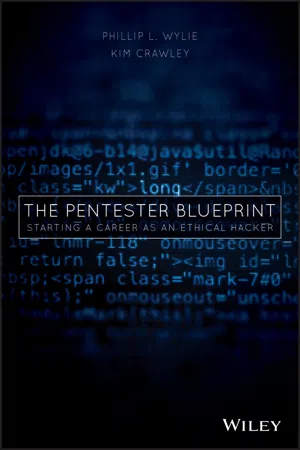
The Pentester BluePrint
Starting a Career as an Ethical Hacker
Phillip L. Wylie, Kim Crawley
- English
- ePUB (handyfreundlich)
- Über iOS und Android verfügbar
The Pentester BluePrint
Starting a Career as an Ethical Hacker
Phillip L. Wylie, Kim Crawley
Über dieses Buch
JUMPSTART YOUR NEW AND EXCITING CAREER AS A PENETRATION TESTER
The Pentester BluePrint: Your Guide to Being a Pentester offers readers a chance to delve deeply into the world of the ethical, or "white-hat" hacker. Accomplished pentester and author Phillip L. Wylie and cybersecurity researcher Kim Crawley walk you through the basic and advanced topics necessary to understand how to make a career out of finding vulnerabilities in systems, networks, and applications.
You'll learn about the role of a penetration tester, what a pentest involves, and the prerequisite knowledge you'll need to start the educational journey of becoming a pentester. Discover how to develop a plan by assessing your current skillset and finding a starting place to begin growing your knowledge and skills. Finally, find out how to become employed as a pentester by using social media, networking strategies, and community involvement.
Perfect for IT workers and entry-level information security professionals, The Pentester BluePrint also belongs on the bookshelves of anyone seeking to transition to the exciting and in-demand field of penetration testing.
Written in a highly approachable and accessible style, The Pentester BluePrint avoids unnecessarily technical lingo in favor of concrete advice and practical strategies to help you get your start in pentesting. This book will teach you:
- The foundations of pentesting, including basic IT skills like operating systems, networking, and security systems
- The development of hacking skills and a hacker mindset
- Where to find educational options, including college and university classes, security training providers, volunteer work, and self-study
- Which certifications and degrees are most useful for gaining employment as a pentester
- How to get experience in the pentesting field, including labs, CTFs, and bug bounties
Häufig gestellte Fragen
Information
1
What Is a Pentester?
With great power comes great responsibility.François Voltaire
Synonymous Terms and Types of Hackers
- White hat hackers Ethical hackers (aka pentesters).
- Gray hat hackers: Gray hats fall into a fuzzy area. Their intent is not always malicious, but it is not always ethical either.
- Black hat hackers: Their intent and purpose are illegal. Cyber criminals fall into this category.
- Threat actor
- Cyber criminals
- Black hat hackers, or black hats for short

Pentests Described
Benefits and Reasons
- Discovering and remediating vulnerabilities in order to mitigate possible breaches.
- Regulatory compliance is a major driver for companies to conduct pentests. Of course, this should not be the only reason—security should be the main purpose. Nonetheless, Payment Card Industry-Data Security Standard (PCI-DSS) and General Data Protection Regulation (GDPR) are two major regulations. They pertain to payment systems ranging from those seen in brick-and-mortar stores to those implemented in ecommerce.
- Security operations center (SOC) analysts
- Network security analysts and engineers
- Digital forensics and incident response (DFIR)
- Purple teams (a collaboration of defensiv...
Inhaltsverzeichnis
- Cover
- Table of Contents
- Title Page
- Foreword
- Introduction
- 1 What Is a Pentester?
- 2 Prerequisite Skills
- 3 Education of a Hacker
- 4 Education Resources
- 5 Building a Pentesting Lab
- 6 Certifications and Degrees
- 7 Developing a Plan
- 8 Gaining Experience
- 9 Getting Employed as a Pentester
- Appendix: The Pentester Blueprint
- Glossary
- Index
- End User License Agreement